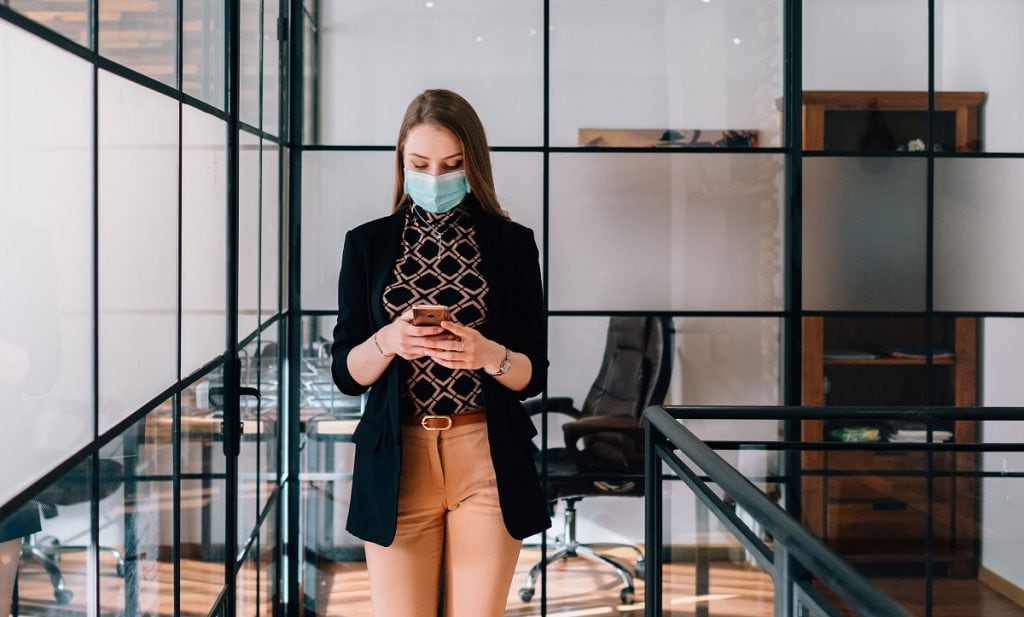Businesses are constantly adopting new technologies and devices to improve workplace safety during the pandemic. Amazon recorded a massive 2000% rise in searches for touchless devices during the recent months. While most businesses are struggling to improve workplace safety, tech solutions offer great potential for tackling infection risk. But how can we keep up with this rapid transformation and adapt to the post-pandemic work environment? Today, we will share some tips to increase workplace safety by using touchless software technologies in offices and businesses.
Motion Activated Lighting
This automated lighting technology helps us to turn on the light when it detects movement. It stays on and turns off when there is no motion. These systems transmit high-frequency radio signals and give a warning if they recognize any activity.
The motion sensors use infrared light to detect heat changes. When you move within its range, this light detects it with an infrared sensor. The sensor signals the device to activate the LED light connected to the detector. Motion-activated lighting eliminates both the unnecessary touch and the effort. By eliminating an important shared point of contact, it could be a small but impactful method of reducing the potential for the spread of germs and disease.
Facial Recognition Technology
The pandemic also increased the use of facial recognition technologies. Although there are still privacy concerns, many consumers now accept facial recognition in the current health crisis. Employees prefer this method of identity verification in offices.
Technologies such as eye-tracking software interact with the environment without the need for contact. These solutions offer the possibility of accessing office resources or a building, activating push buttons in elevators, withdrawing cash at an ATM, or operating equipment or devices in work environments.
Similarly, many smart tools allow you to monitor workplace insights for better managing employee safety. SenseTime, a Chinese Artificial Intelligence company, developed a facial recognition system to prevent the population’s massive contagion. Thermal and facial recognition cameras are not new. However, today, businesses are using it at workplaces to identify people who are not wearing face masks.
Intelligent Bathrooms
The smart toilet is a trend that kicked off in Japan a few decades ago. It was a great revolution in the world of personal hygiene. Today, the pandemic situation increased its demand in almost every professional setting. A smart bathroom usually has services controlled by a device combined with technology that keeps the toilet easy to clean, free of bacteria, and therefore totally hygienic. A smart toilet has all the features that offer a more robust solution. Some relevant features of this technology are:
- Water jets with temperature and pressure level control
- Male / female wash bidet
- Warm air drying
- Odor removal system
- Automatic cleaning
- Proximity recognition to greet you and lift the lid
- Remote control for spray and other functions
- Antibacterial solution
Automatic Doors
Did you know that traditional doors are a source of germs and viruses? Many people touch doors every day, which is a big problem in workplaces with many employees. Automatic doors solve this problem since no one needs to touch them. Automatic doors have a mechanism that allows us to open doors without pushing them. It uses an electric system with motion-activated sensors. The optical or motion sensor signals the transmission device that controls a clutch mechanism connected to a sprocket and the door.
Automatic Soap Dispensers And Mixers
Washing our hands correctly and frequently is essential if we want to eliminate all kinds of germs. Having an automatic control unit for soap dispensers in our workplace is extremely important when offering a correct hygiene service. The most attractive and innovative devices include a sensor that deposits soap for handwashing. It helps you avoid direct contact with the dispenser.
Bluetooth Technology For Touchless Workplaces
Similarly, a startup in San Francisco uses Bluetooth technology to allow access to workplaces, doors, and elevators to implement touchless solutions. Proxy is among the leading companies that are creating touchless software solutions based on Bluetooth technology.
Touchless Meeting Rooms
The new contactless meeting room solution gives employees the certainty of a safe meeting location at a workplace after COVID. The wireless charging technology with cloud connection offers an unprecedented, touchless meeting room solution. It ensures that employees are more secure at work when using common spaces. The solution integrates with leading meeting room planning software to enable instant check-in and seamlessly start video conferencing activities.
Voice Interfaces
Another solution that is minimizing contact at workplaces is the voice interface. The technology consulting firm’s report points out that voice-based tools are an excellent investment choice for organizations. Many companies are automating processes and allowing their users to interact with their systems through voice. An analysis by the Juniper consultancy calculated that in the United States alone, sales made through voice assistants would add up to $80 billion in 2023. It is an evolution reinforced by advances in voice biometrics, which identifies and verifies people’s identity by speaking and their tone.
Conclusion
Touchless technology in workplaces will completely change the automated access control systems for entering and leaving offices. Businesses with high-level security needs can explore retina scanning or facial recognition software to ensure safe entry to their facilities. Some of the latest facial recognition technologies for office access allow registered staff members to enter and exit the premises with ease and complete security. These solutions use image processing algorithms that interact with a 3D camera to protect the system’s reliability. Even business transactions, which typically involve an unnecessary amount of contact, are evolving to digital payment systems that do not require machine handling. As COVID-19 encourages businesses to buy contactless technologies in unprecedented numbers, is it possible to imagine that these technologies will soon be part of our daily lives?
